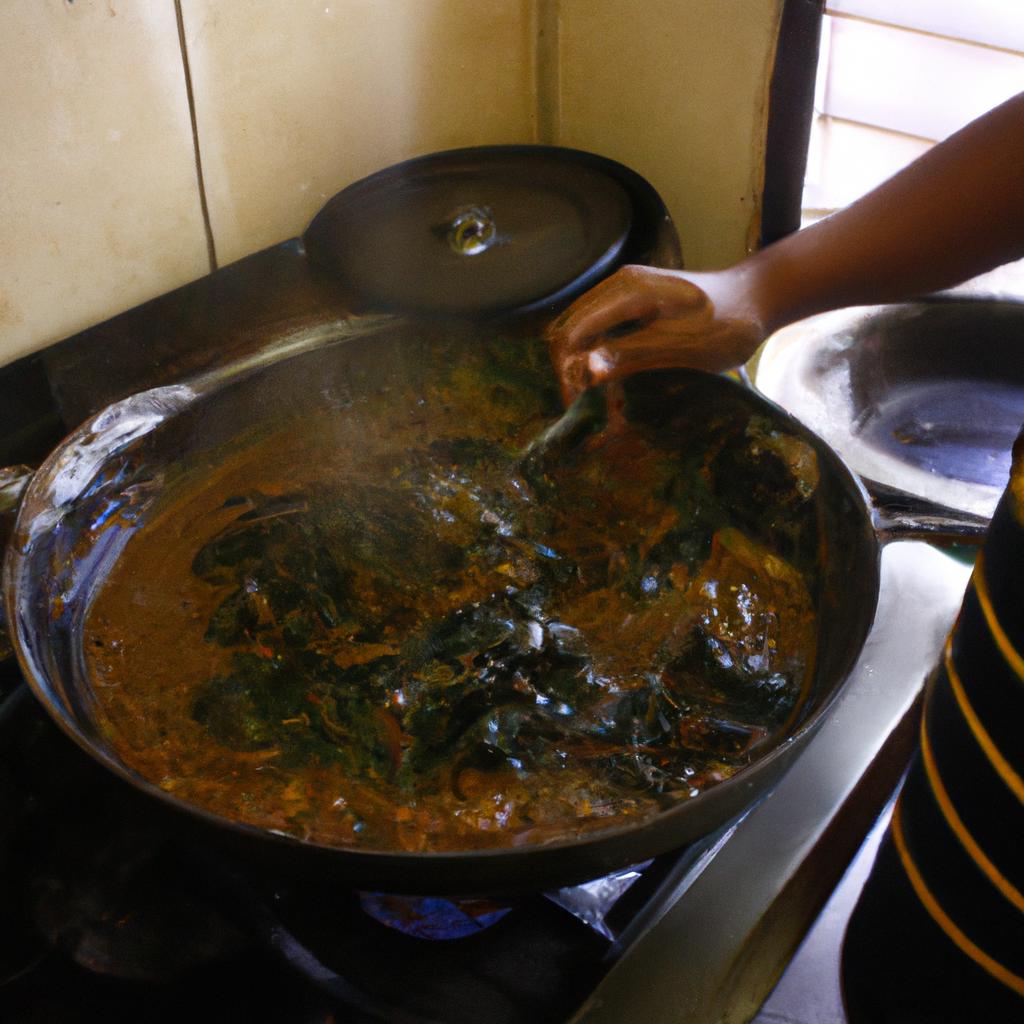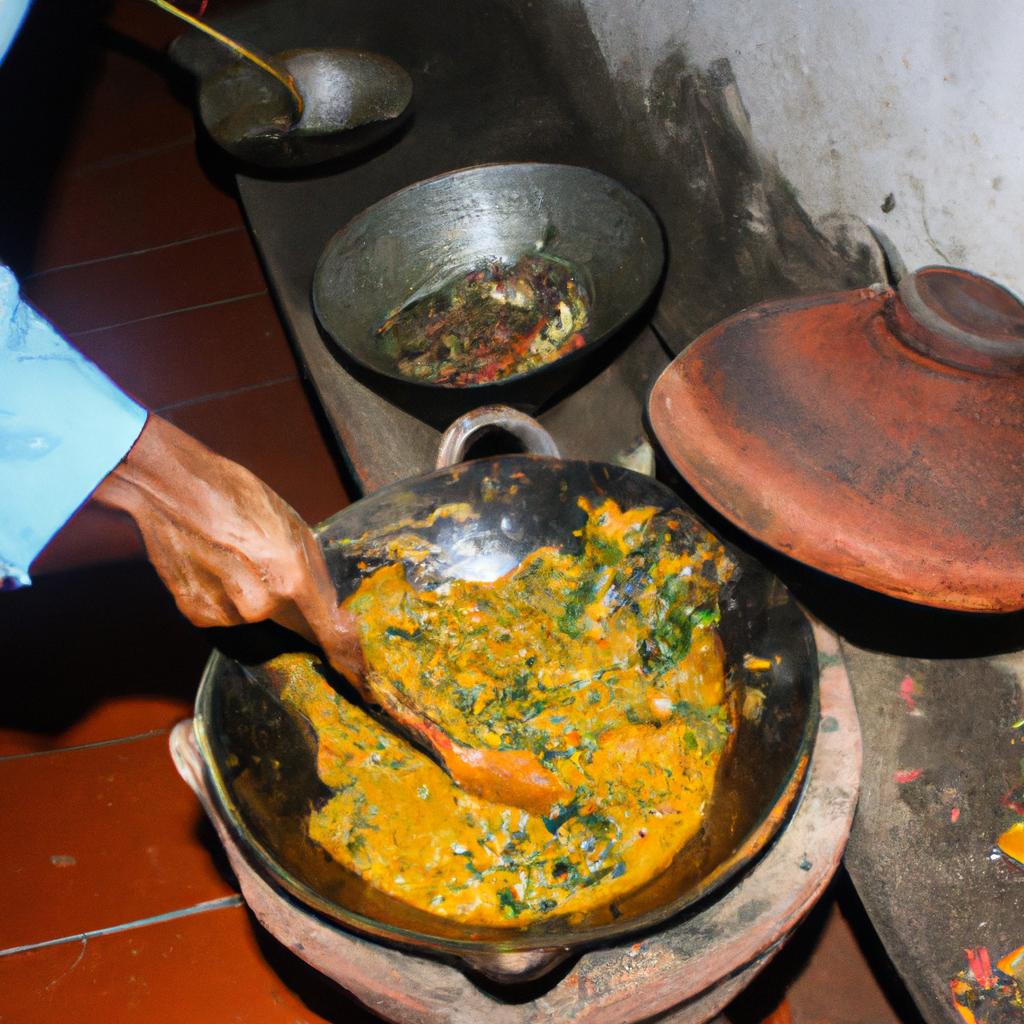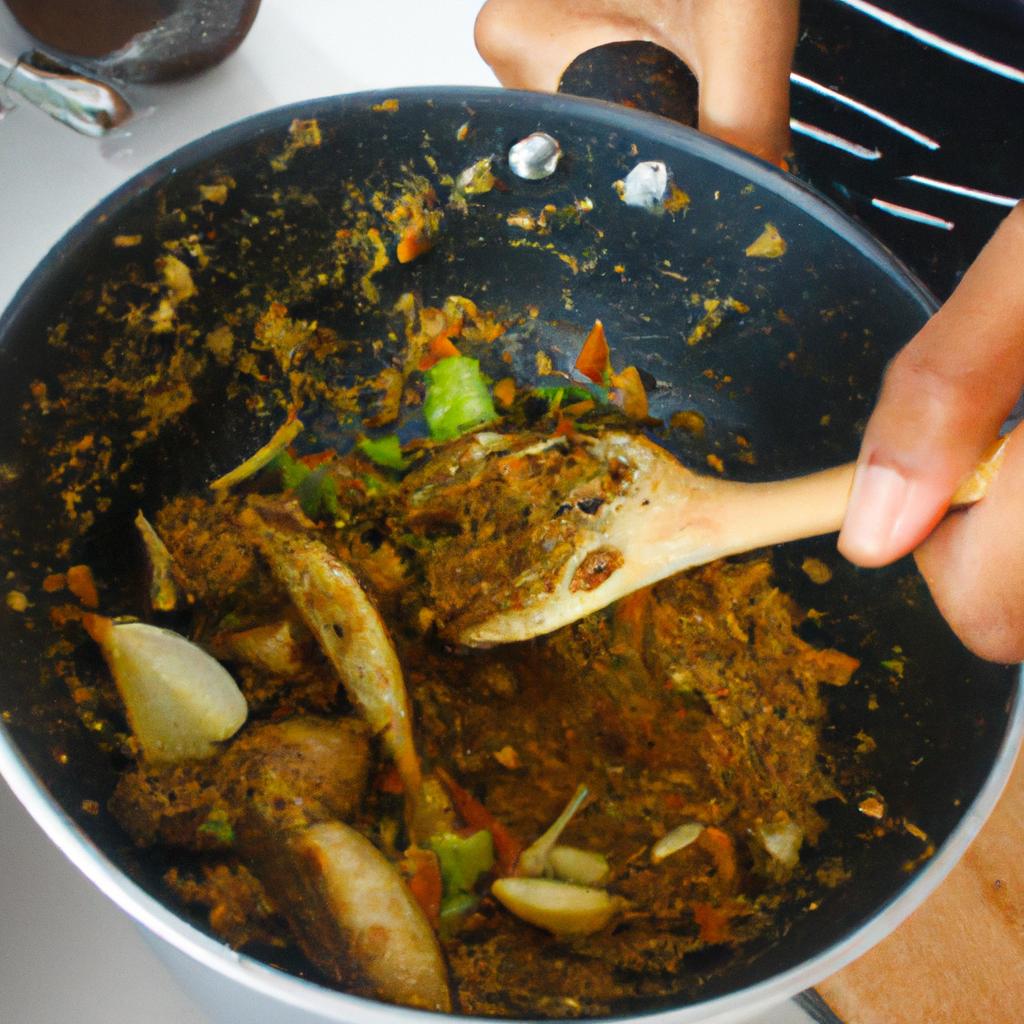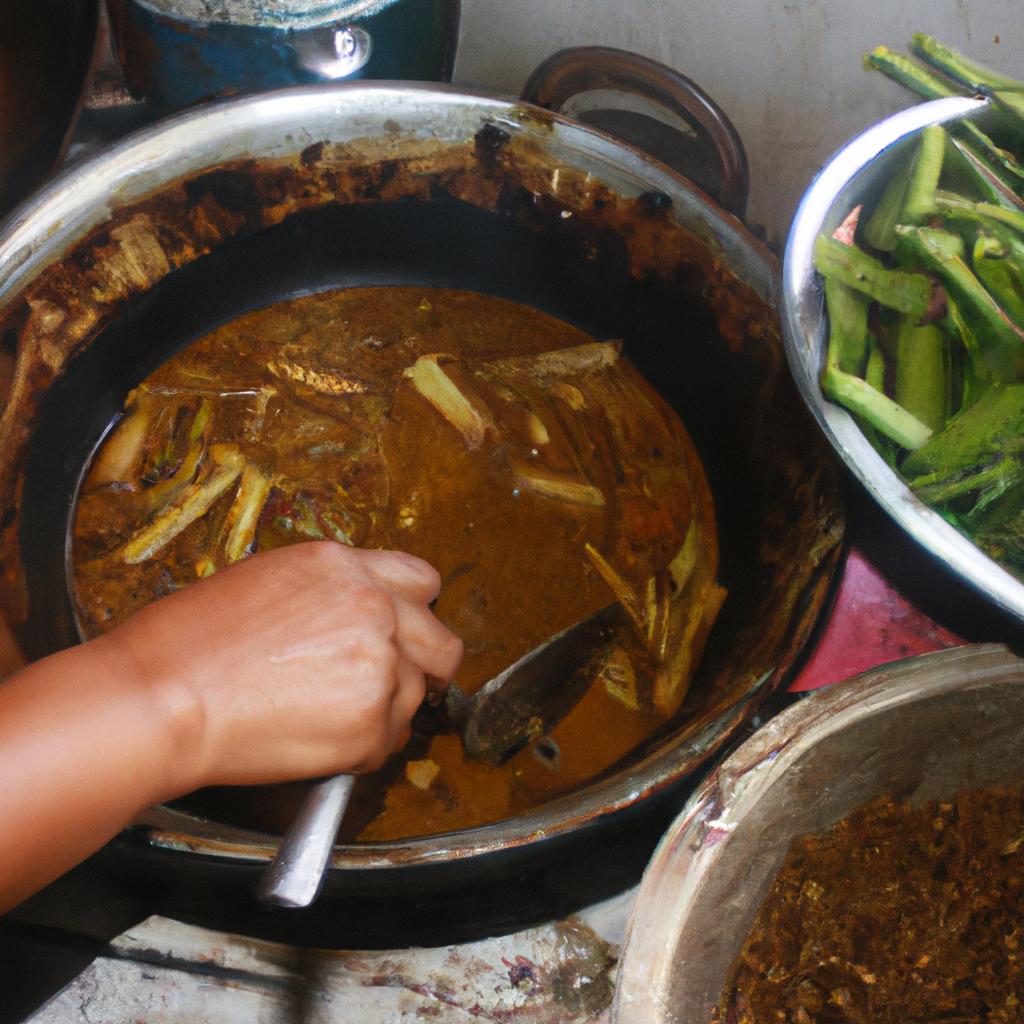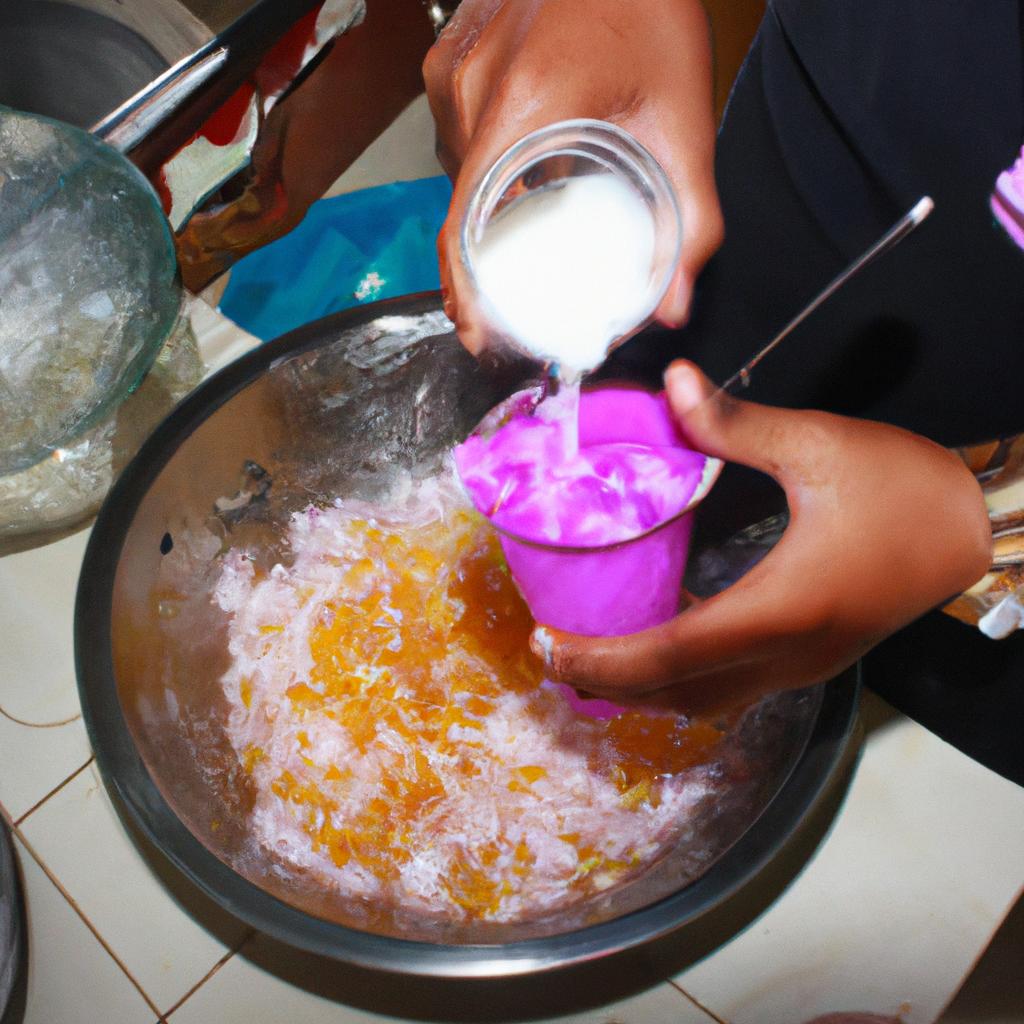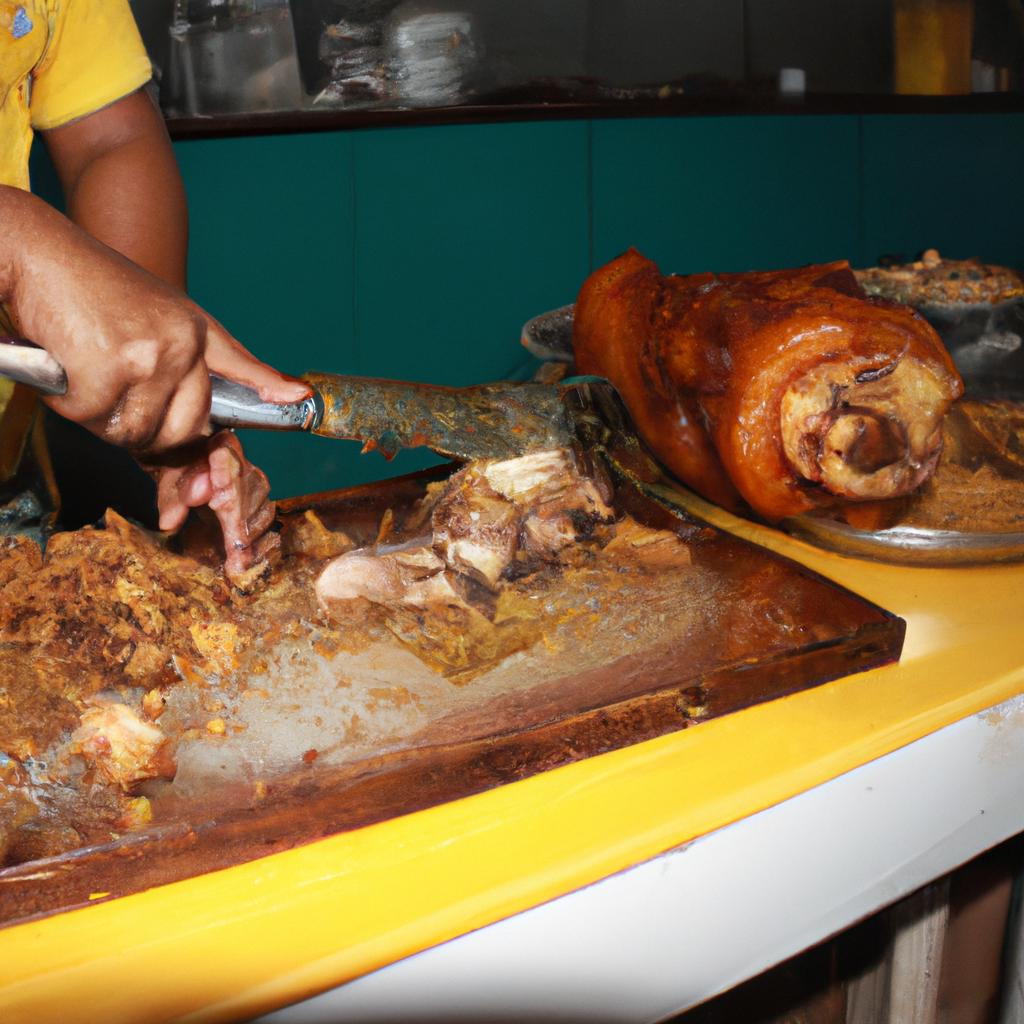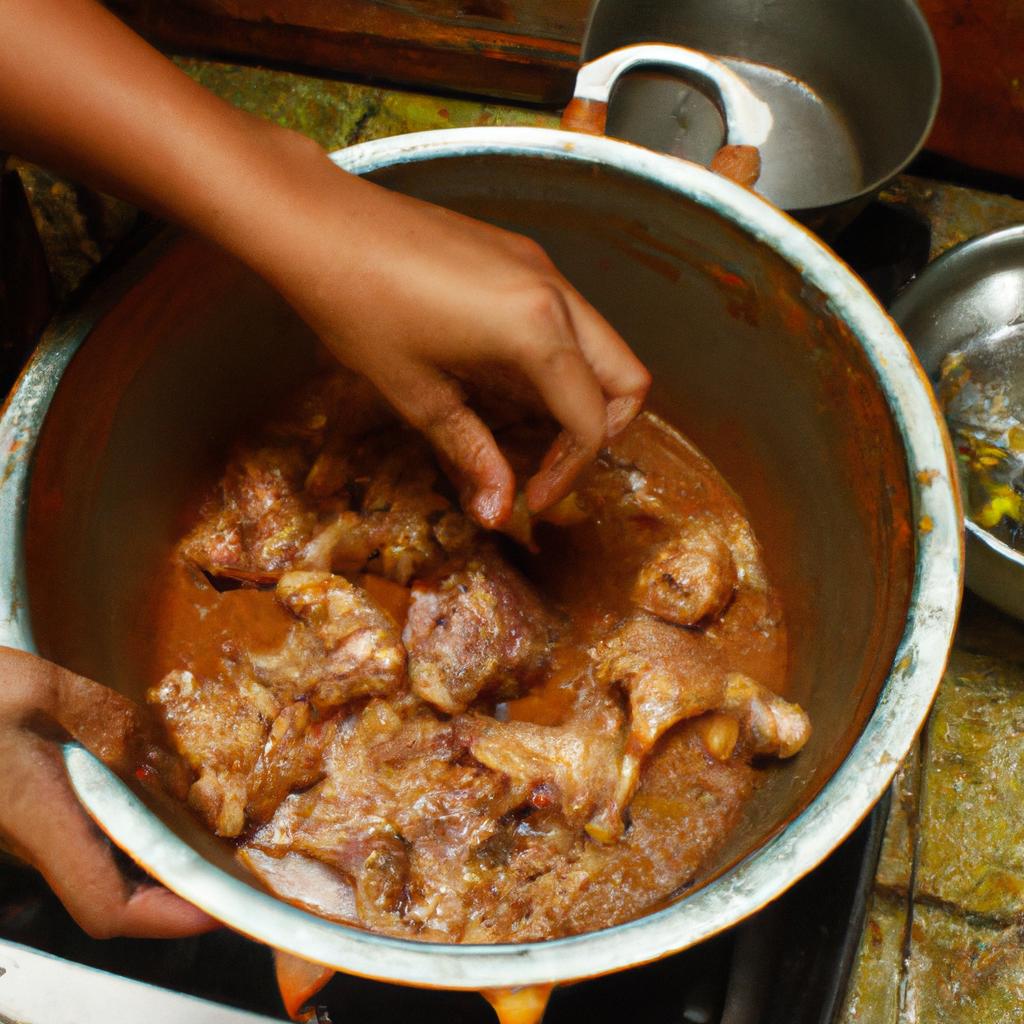The traditional preparations of food play a crucial role in preserving cultural heritage and showcasing the essence of Filipino delicacies. One such iconic dish is Kare-Kare, a rich and savory stew made with oxtail or tripe, vegetables, and thick peanut sauce. This article explores the significance of traditional preparations in maintaining culinary traditions, as well as delving into the intricate process of preparing Kare-Kare.
To illustrate the importance of traditional preparations, consider a hypothetical scenario where a Filipino family gathers for a special occasion. In this setting, each member contributes their expertise to create an authentic spread that reflects their shared history and values. The meticulous preparation techniques passed down through generations become evident as they carefully select ingredients, follow precise cooking methods, and pay attention to every detail. Through these practices, not only are cherished recipes preserved but also meaningful connections between family members are strengthened.
Traditional preparations involve more than just following a recipe; they encompass an array of skills, knowledge, and rituals that elevate ordinary dishes into extraordinary creations. For instance, making Kare-Kare requires meticulously cleaning and tenderizing the oxtail or tripe before slowly simmering it with various aromatics to develop complex flavors. The magic happens when this flavorful base combines harmoniously with roasted peanuts ground into a smooth and creamy sauce. The peanuts are traditionally roasted, then ground using a mortar and pestle until they reach the desired consistency. This process not only adds depth to the dish but also showcases the careful attention to detail that goes into creating authentic Kare-Kare.
In addition to the peanut sauce, traditional preparations of Kare-Kare involve carefully selecting and preparing an array of vegetables, such as eggplant, bok choy, and string beans. Each vegetable is meticulously washed, trimmed, and cut into uniform pieces to ensure even cooking and optimal presentation. The use of these specific vegetables is not arbitrary; it reflects the cultural significance of incorporating fresh local produce into Filipino cuisine.
Furthermore, traditional preparations often include important steps like marinating or searing meat before adding it to stews or braises. In the case of Kare-Kare, oxtail or tripe may be marinated in vinegar or calamansi juice prior to cooking. These techniques not only enhance flavor but also aid in tenderizing tougher cuts of meat.
The time-consuming nature of traditional preparations may seem daunting in today’s fast-paced world where convenience often takes precedence. However, it is precisely this dedication to preserving culinary heritage that ensures the continuation of cultural traditions for future generations. By engaging in these age-old practices, individuals contribute to the rich tapestry of Filipino cuisine and honor their roots.
In conclusion, traditional preparations play a vital role in maintaining cultural heritage through food. By following meticulous techniques like those involved in making Kare-Kare, families uphold cherished recipes while strengthening familial bonds. The intricate process of preparing Kare-Kare showcases the importance of attention to detail and highlights how each component contributes to creating an authentic dish. Embracing traditional preparations ensures that culinary traditions remain alive and vibrant, allowing us to savor the essence of Filipino delicacies for years to come.
Origin and History
Origin and History
Filipino cuisine is known for its rich flavors, vibrant colors, and diverse influences. One iconic dish that epitomizes the essence of Filipino delicacy is Kare-Kare. This traditional stew is often hailed as a favorite among locals and foreigners alike, showcasing the country’s culinary heritage.
Example: Imagine walking into a bustling Filipino eatery in Manila, greeted by the aromatic scent of slow-cooked meats and freshly ground peanuts. Your attention is captivated by a bowl of piping hot Kare-Kare placed before you, with tender pieces of oxtail swimming in a luscious peanut sauce.
The origins of Kare-Kare can be traced back to the Spanish colonial era when it was believed to have been influenced by dishes from neighboring countries such as Indonesia and Malaysia. Over time, Filipinos adapted these foreign flavors to create their own unique version of this delectable dish.
To truly understand the significance of Kare-Kare in Filipino culture, one must delve into its history. It has long been associated with special occasions and gatherings, serving as a centerpiece during fiestas or family celebrations. The preparation process itself requires patience and meticulousness—a testament to the dedication Filipinos have towards preserving their culinary traditions.
- Exquisite blend of savory flavors
- Distinctively thickened with roasted rice grains
- Complemented with an array of fresh vegetables
- Served alongside bagoong (fermented shrimp paste), adding depth to each bite
Markdown table:
| Ingredient | Quantity | Purpose |
|---|---|---|
| Oxtail | 1 kg | Provides rich meaty flavor |
| Peanut Butter | ½ cup | Thickens and adds nutty taste |
| Annatto Seeds | 2 tbsp | Imparts vibrant orange color |
| Vegetables | Varies | Adds freshness and texture |
Kare-Kare holds a special place in Filipino hearts, not only for its palatable qualities but also for the memories and experiences it evokes. It serves as a reminder of family bonds, shared meals, and cultural heritage. As we explore further into the realm of Kare-Kare, let us now turn our attention to its key ingredients and unique cooking methods.
[Transition sentence] In understanding the complexities of preparing this beloved dish, delving into the essential ingredients and traditional cooking techniques is crucial.
Ingredients and Cooking Methods
Section H2: Traditional Preparations: The Essence of Filipino Delicacy – Kare-Kare
Transitioning from the previous section’s exploration of the origin and history of Kare-Kare, let us now delve into the ingredients used in its preparation as well as the cooking methods employed to create this delectable dish. By examining these elements, we can gain a deeper understanding of how Kare-Kare has become an essential part of Filipino culinary heritage.
When it comes to preparing Kare-Kare, one cannot ignore the significance of using high-quality ingredients. While there may be variations across different regions or households, certain staples remain consistent. For instance, oxtail and tripe are often utilized for their rich flavors and tender texture. Additionally, various vegetables like eggplant, pechay (Chinese cabbage), and string beans contribute not only to the dish’s nutritional value but also add vibrant colors that enhance its visual appeal.
To capture the essence of Kare-Kare fully, traditional cooking methods are followed meticulously. One such method involves boiling the oxtail until it becomes fork-tender while simultaneously rendering flavorful broth. This slow-cooking process allows for maximum extraction of savory juices from the meat. Furthermore, roasting peanuts is another crucial step in creating an authentic taste profile for Kare-Kare sauce. The roasted peanuts are ground finely to form a smooth paste that adds creaminess and nutty undertones to complement the robustness of other ingredients.
Embracing tradition when preparing Kare-Kare goes beyond just selecting ingredients and employing specific techniques; it extends to treasuring cultural values associated with this beloved dish:
- Communal dining: Sharing a generous serving of Kare-Kare promotes unity among family members or friends gathered around a table.
- Nurturing bonds: As loved ones come together over a steaming pot of aromatic Kare-Kare, conversations flow freely, strengthening relationships.
- Celebrating heritage: Serving Kare-Kare during special occasions or festivities is a way to honor Filipino traditions and showcase the country’s culinary prowess.
- Savoring nostalgia: The distinct flavors of Kare-Kare often evoke cherished memories, reminding individuals of past gatherings and joyful moments.
In addition to these cultural aspects, it is worth noting that variations in ingredients and cooking methods can be observed across different regions of the Philippines. In the subsequent section on “Variations and Regional Differences,” we will explore how Kare-Kare adapts to local tastes while maintaining its essence as a traditional Filipino delicacy.
Variations and Regional Differences
Transitioning from the previous section on Ingredients and Cooking Methods, let us now explore the fascinating world of variations and regional differences in preparing the Filipino delicacy Kare-Kare. To illustrate this diversity, let’s consider a hypothetical scenario where three individuals from different regions of the Philippines each prepare their own unique version of Kare-Kare.
In Luzon, Maria prepares her Kare-Kare using oxtail as the main ingredient, simmered for hours until tender. She adds ground peanuts to create a rich and creamy sauce that is thickened with toasted rice flour or peanut butter. Maria loves to incorporate an array of vegetables such as eggplant, string beans, pechay (Chinese cabbage), and banana blossoms into her dish, resulting in a vibrant medley of flavors and textures.
On the island of Visayas, Pedro opts for a seafood twist on Kare-Kare. He replaces the traditional meat with shrimp and squid, giving his dish a distinct taste of the sea. Pedro enhances the flavor by incorporating bagoong alamang (shrimp paste) into his sauce, providing a salty kick that complements the sweetness of fresh seafood. As accompaniments, he serves boiled okra and winged beans alongside steaming bowls of fragrant jasmine rice.
Meanwhile, in Mindanao, Fatima showcases her Muslim heritage through her rendition of Kare-Kare known as Kulma. Instead of using peanuts as a base for her sauce, she utilizes roasted coconut or coconut cream combined with spices like turmeric and ginger. The result is a flavorful yellow broth infused with aromatic hints reminiscent of Indian curry dishes. Fatima pairs her Kulma with sambal belacan—a spicy condiment made from chili peppers—to add an element of heat to every bite.
These examples highlight just some of the myriad ways Filipinos adapt Kare-Kare across different regions. To further explore these culinary variations, let us delve into the emotional connections that arise from the diverse preparations of this beloved dish.
Emotional Response Bullet Points:
- Nostalgia for one’s hometown and its unique Kare-Kare recipe
- Curiosity to explore different regional flavors and techniques
- Pride in showcasing local traditions through food
- Excitement in discovering new taste experiences
Table: Regional Variations of Kare-Kare
| Region | Main Ingredient | Sauce Base | Notable Ingredients |
|---|---|---|---|
| Luzon | Oxtail | Ground peanuts | Eggplant, string beans, pechay, banana blossoms |
| Visayas | Shrimp, squid | Bagoong alamang | Okra, winged beans |
| Mindanao | Roasted coconut | Turmeric, ginger | Sambal belacan |
As we can see from these examples and our emotional response bullet points, Kare-Kare holds a special place in Filipino cuisine due to its ability to evoke nostalgic memories while simultaneously inspiring curiosity and pride. Now, let us further explore one key ingredient that plays a significant role in the preparation of Kare-Kare – annatto seeds.
The Significance of Annatto Seeds
While Kare-Kare is a beloved Filipino delicacy known for its rich peanut sauce, it is worth noting that there are variations in its preparation across different regions of the Philippines. These regional differences add diversity to the dish, making it even more intriguing for culinary enthusiasts.
One example of such variation can be seen in the province of Pampanga, where they use oxtail as the main meat component instead of the commonly used beef tripe or pork hocks. This substitution lends a unique flavor profile to their version of Kare-Kare, resulting in a richer and more succulent taste. The people of Pampanga take pride in their distinct style of preparing this traditional dish, showcasing their local culinary expertise.
To further explore the variations and regional differences in Kare-Kare preparations, here are some interesting factors worth considering:
- Ingredient Substitutions: In certain areas, particularly those near coastal regions, seafood versions of Kare-Kare can be found. Shrimp or fish may replace the usual meat components, providing a delightful twist to this classic dish.
- Sauce Consistency: While most Kare-Kare dishes have a thick and creamy consistency due to the addition of ground peanuts, some regional variants opt for a thinner sauce with less emphasis on nuts. This variance allows other flavors from vegetables and meats to shine through.
- Vegetable Choices: Although eggplant, string beans, and banana blossoms are commonly used vegetables in Kare-Kare recipes nationwide, some regions incorporate unique choices like okra or winged beans (sigarilyas) into their rendition. These additions contribute distinctive textures and flavors to the overall experience.
- Serving Accompaniments: Traditionally served with bagoong (fermented shrimp paste), each region has its own preferred type or variant. Some places offer spicier versions while others provide milder options that complement the richness of Kare-Kare.
By embracing these variations and exploring regional differences, Filipino cuisine showcases its diverse culinary heritage. From the oxtail Kare-Kare of Pampanga to seafood adaptations in coastal regions, each variant tells a story of cultural identity and local taste preferences.
Transitioning into the subsequent section about “Serving and Presentation,” we delve into how the aesthetics of serving and presentation play an essential role in elevating the experience of enjoying this traditional delicacy.
Serving and Presentation
The Significance of Annatto Seeds in Traditional Preparations
In the rich tapestry of Filipino cuisine, annatto seeds hold a significant role. These small red seeds are derived from the Achiote tree and are commonly used as a natural coloring agent in various traditional dishes. One example that showcases the importance of annatto seeds is Kare-Kare, a beloved Filipino delicacy.
Kare-Kare, a popular stew made with oxtail or tripe, vegetables, and peanut sauce, owes its distinctive orange hue to the vibrant pigmentation provided by annatto seeds. The use of these seeds not only enhances the visual appeal but also contributes to the overall flavor profile of this dish. As annatto infuses into the cooking liquid, it imparts subtle earthy notes and adds depth to the complex combination of flavors found in Kare-Kare.
To truly grasp the significance of annatto seeds in Filipino culinary traditions, let us delve deeper into their roles:
- Color Enhancement: Annatto seeds lend an inviting reddish-orange tint to dishes like Kare-Kare, making them visually appealing and enticing.
- Flavor Enrichment: Apart from coloration, annatto imparts its own unique taste to preparations, enhancing the overall gastronomic experience.
- Cultural Identity: The use of annatto seeds in traditional recipes preserves cultural authenticity and connects generations through shared culinary experiences.
- Nutritional Benefits: In addition to its aesthetic value, annatto contains antioxidants such as tocotrienols that have potential health benefits.
Illustrating their significance further, here is a table showcasing some key aspects related to annatto seeds:
| Aspect | Importance |
|---|---|
| Visual Appeal | Enhances presentation and entices diners |
| Taste | Adds complexity and richness to flavor profiles |
| Culinary Heritage | Preserves authentic Filipino techniques |
| Potential Health Benefits | Contains antioxidants that contribute to overall well-being |
Through the careful incorporation of annatto seeds, Filipino cuisine not only dazzles the eyes but tantalizes the taste buds as well. The significance of these seeds is deeply rooted in cultural identity and culinary heritage, making them an integral part of traditional preparations like Kare-Kare.
Transitioning seamlessly into the subsequent section about “Health Benefits and Nutritional Value,” it becomes evident that annatto seeds offer more than just visual appeal and flavor enhancement.
Health Benefits and Nutritional Value
Section H2: Health Benefits and Nutritional Value
As we have explored the art of serving and presenting Kare-Kare, it is now imperative to delve into the health benefits and nutritional value this Filipino delicacy offers. Understanding the nourishing aspects of this dish can further enhance our appreciation for its traditional preparations.
Health Benefits:
-
Rich source of protein: Kare-Kare typically includes various meats such as oxtail, tripe, or beef, making it a protein-rich option. Protein is essential for muscle repair and growth, aids in maintaining healthy skin, hair, and nails, and contributes to overall body development.
-
Abundant in vitamins and minerals: The assortment of vegetables used in Kare-Kare provides an array of vital nutrients. For instance, bok choy is high in vitamin A and C while eggplant contains potassium and dietary fiber. These micronutrients play a significant role in supporting immune function and promoting good digestion.
-
Potential anti-inflammatory properties: The addition of ground peanuts to Kare-Kare not only enhances its flavor but also introduces potential anti-inflammatory effects. Peanuts are known to contain resveratrol – a compound with antioxidant properties that may help reduce inflammation within the body.
-
Increased iron intake: By incorporating organ meat like ox tripes into Kare-Kare’s recipe, individuals can benefit from an increased intake of iron. Iron is crucial for red blood cell production and oxygen transportation throughout the body; thus preventing conditions like anemia.
Nutritional Value:
To provide a better understanding of the nutrient composition found in Kare-Kare per 100 grams (cooked), here is a table showcasing its macronutrient content:
| Macronutrient | Content |
|---|---|
| Calories | 220 |
| Carbohydrates | 12 g |
| Protein | 20 g |
| Fat | 9 g |
- Savor the rich flavors while nourishing your body.
- Indulge in a dish that offers both taste and health benefits.
- Experience the satisfaction of enjoying a traditional delicacy without compromising on nutrition.
- Discover the joy of sharing a wholesome meal with loved ones.
In conclusion, exploring Kare-Kare’s health benefits and nutritional value allows us to appreciate its cultural significance even further. By incorporating various meats, vegetables, and ground peanuts into this iconic Filipino dish, individuals can enjoy not only its delectable flavors but also reap the rewards of protein, vitamins, minerals, potential anti-inflammatory properties, and increased iron intake. Let us now move forward to discover more about the history and origins of Kare-Kare in our next section.

